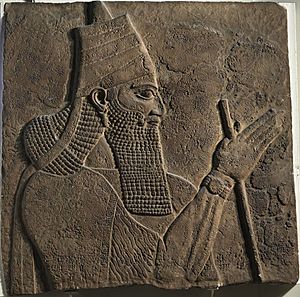Šamši facts for kids
Quick facts for kids Šamši |
|
|---|---|
| Queen of Qedar | |
| Reign | c. 735–710 BCE |
| Predecessor | Possibly Zabibe |
| Successor | Possibly Yatie |
| Born | c. 8th century BCE |
| Religion | North Arabian polytheism |
Šamši was a powerful Arab queen who ruled in the ancient Middle East around 700 BC. She became queen after Zabibe. Šamši was known for her strength and for challenging the mighty Assyrian Empire.
The Assyrian king, Tiglath-Pileser III, was the first foreign ruler to control the Arabs. Queen Šamši joined other leaders to fight against him. Even though she was defeated, she was allowed to keep her throne after paying a special tax called a tribute. She ruled for about 20 years. After her, Queen Iatie became the next ruler.
Contents
A Queen's Challenge to Assyria
Ancient records from Assyria describe Queen Šamši as a very strong leader. She was brave enough to stand up to the Assyrian kings in the 730s and 720s BC. Šamši and other rulers from lands far to the west traded valuable spices with the Assyrians.

Šamši, along with the queens before and after her, led groups of traders. These groups carried spices and special perfumes called incense. They traveled from the Arabian Peninsula to the Near East and Syria.
Becoming Queen and Making an Oath
Šamši became queen with the support of Assyria. She took over from Queen Zabibe, who had stepped down. When Šamši became queen, she promised to be loyal to Assyria. She swore this promise by the sun, which was a god in Arabia. King Tiglath-Pileser officially recognized her as queen.
However, Šamši later changed her mind. She decided to rebel against Assyria. In 732 BC, she joined an alliance with Rezin of Damascus. Together, they planned to fight against the Assyrian king, Tiglath-Pileser III.
The Battle and Defeat
The Assyrian army, led by King Tiglath-Pileser III, was very strong. They had recently taken control of the land of Edom. Now, they turned their attention to the groups fighting against them in Arabia.
According to Assyrian records, Tiglath-Pileser attacked many Arab areas. He defeated Queen Šamši near a place called Mount Sa-qu-ur-ri. The Assyrians captured many soldiers. They also took a huge amount of treasure, including 30,000 camels and over 20,000 oxen.
An old inscription says that 9,400 of Šamši's soldiers were killed. The Assyrians also took 5,000 bags of different spices. They seized religious altars, weapons, and even a special staff belonging to Šamši's goddess. As Šamši escaped into the desert, Tiglath-Pileser burned the remaining tents at the battle site.
Šamši's Surrender and Return to Power
After her defeat, Assyrian writers said that Queen Šamši ran away from the battle. But she was not free for long. She was soon captured and brought to King Tiglath-Pileser.
The king decided to put a governor, called a qepu, in charge of her and 10,000 soldiers. Then, he allowed her to return to her kingdom. It is also said that she escaped to the land of Bazu/Basu and later gave up.
To keep her power, Šamši had to agree to pay a tribute to Tiglath-Pileser. The Assyrians wanted a friendly Arab ruler. This was important for keeping the valuable trade routes open. These routes went from Assyrian lands across Arabia.
Seven other kingdoms involved in trade also had to pay tribute. They also had to help keep the incense trade safe. These kingdoms included Massa, Tyma, Saba, Haiappa (Ephah), Badana, Hattia, and Idibi'lu. The Arabs agreed to pay tribute with gold, silver, camels, and all kinds of spices.
See also
 In Spanish: Samsi para niños
In Spanish: Samsi para niños
- Dumat al-Jandal
- Arab queens

